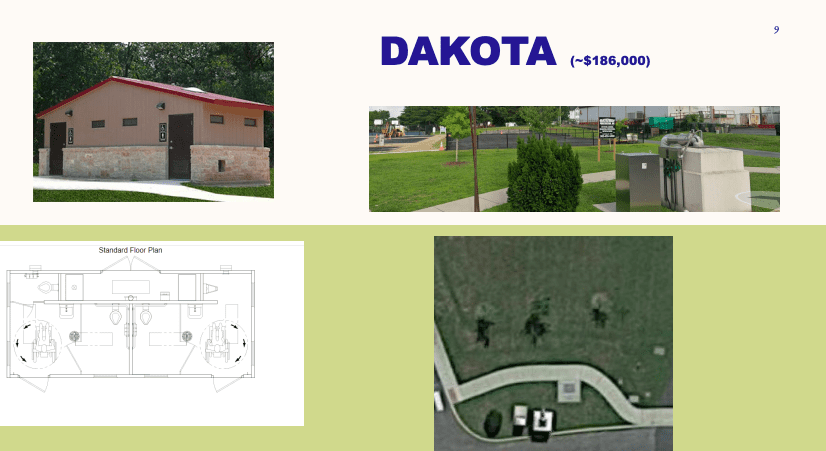After the third presentation by Public Works Director Mike Svaby, Milford City Council approved the purchase of a prefabricated restroom for Memorial Park. The new restroom will be located across from the Milford Public Library. Svaby was asked to reach out to contractors to see if it would be less expensive to design and construct a restroom as opposed to buying a prefabricated model.
“Members of council, I submitted something for your packet with a recommendation. But just kind of a quick recap of where this subject matter has been. On this third instance of review, we first presented the package recommending we procure a prefabricated unit from CXT,” Svaby said. “And after some discussion here in this forum, we agreed that we wanted to see some more options. So, in the previous council meeting to this one, I brought back three different options that would fit in the buildable footprint on 5 South Washington Street across from the library. And after talking about those it was more the size and features that we wanted. I believe it was Councilman Culotta that had initiated an interest in evaluating the expectation of cost to have a building built on site in a conventional fashion from a design.”
Svaby explained that he approached Richard Y. Johnson, the general contractor for the police station, to provide an estimate for building a restroom rather than use one that is prefabricated. He provided the contractor with the same specifications of the Dakota, which was the preferred model among the three units presented. Svaby also provided specifications for the Cortez, which was also well-received. The cost to install the Dakota was $186,000 with $60,000 site costs, averaging $1,253 per square foot, a total of $246,000. The Cortez cost was $153,000, with the $60,000 site costs, an average of $788 per square foot, a total of $213,000.
“For the Dakota, something worth note here, that it didn’t really occur to me until we began to look at it from another perspective is we would have a site contractor, preparing the utilities and lining up the utility stubs and then we would have CXT shipping the completed unit in pieces, and we would have the unit’s craned into place,” Svaby said. “Obviously, a high end operation of high precision in terms of lining everything up. But other than having CXT deliver the unit and crane it in my mind it leaves a lot of opportunity for risk both with the shipment of the product itself and then the ultimate placing.”
There is a site design for utilities, Svaby stated, but that will need to be finalized by a site contractor which allows room for error. There are also multiple parties involved in getting the prefabricated unit set in place. Svaby reached out to RY Johnson to see if they could act as general contractor for the project. This would mean they would design, build and offer a turnkey operation. The estimated price was $284,007, or around $961 per square foot. The timeframe for having the prefabricated unit installed and the stick-built version was virtually the same with the stick built version estimated to take just a week longer to complete.
“Knowing that this is more than the costs that were quoted for the actual production shipping and an alignment of the unit plus still having concern about risk and multiple parties being involved, I am going to recommend that we proceed with having the general contractor bid with a design that we would if you all agree to the recommendation that we would award to a state contractor Becker Morgan,” Svaby said. “They would do the design and then we would go out to bid for an RFP and that would be professional services and evaluation. We would entertain proposals, score them and award the best choice. I believe in the competitive environment; we might get better pricing than we have here which was an estimate.”
Councilman Jason James pointed out that the cost for designing and building the restroom was higher than the cost of the prefabricated option. Svaby stated that although that was correct, the prices were estimates and could come in lower at bid. He also felt that using a general contractor would reduce the risk of things going wrong.
“Because we have experts in house relating to what is required for site work,” Councilman James said. “What’s required for an engineer, what’s required for utilities and all the like, we can reduce the risk of things going wrong. I can’t, in my mind, see why all those other things being neutral, why we would do anything other than continue with the prefab.”
Svaby stated that his concern was the element of risk as one contractor could be held responsible. Councilman James felt that they were “big boys and girls” and that the city could manage that.
“Thank you, Mr. James, that is the way I was thinking as well. Last time you were here I was ready to go. So, my first thought, we did a disservice in not doing everything at once. So, we can have apples and oranges and make that comparison initially. That’s my first thought,” Councilwoman Katrina Wilson said. “But moving on from that, I feel the same way that Mr. James does. We’ve got all these high experts, staff employees and services for the city of Milford so the risk should not be that big because we have these experts and those individuals that will bring the prefab in. We use our experts, it’s like making that a big mountain and it really doesn’t have to be and we always want to do what’s best for our citizens who we are responsible for. Something you say all the time. But we all feel the same way. I mean, I’m glad that you went out and did that. But I still feel the same way.”
Looking at the pricing, Councilman Andy Fulton pointed out that the Dakota would cost $246,000 while the stick built estimate was $285,000. He felt that going with the Dakota would save the taxpayers $38,000. Councilman Mike Boyle asked what the site costs entailed.
“The manufacturer of the unit actually cranes it in and that’s included,” Svaby said. “What the site contractor will do, they will source electric, water and sewer from the nearby facility closest location, and they’ll be responsible to stub off from the source according to the footprint of the unit and where those utilities need to be connected.”
There would likely not be a concrete pad necessary, Svaby explained, as the manufacturer indicated they would prefer a stone base with concrete surrounding the unit. Councilman Dan Marabello asked what materials would be used for the stick built unit as well as the prefab unit.
“What I did was I provided RY Johnson for their estimates the same material that was available on the website for the actual manufactured units. And I specified any individual details that we identified to CXT when we got an exact price,” Svaby said. “So, if we wanted our exterior envelope to be block or brick and look just like the pump station in the parking lot, the estimators were aware of that if we were to do a standing unit, the roof estimators were aware of that. So, including the internal amenities, the stainless steel fixtures, sink, commode changing station, all of that would basically be the same.”
Another question from Councilman Marabello was the track record of the company creating the prefabricated units.
“They say they have a good track record of not having any problems, I believe. They actually provided the unit that we have out at the Boys and Girls Club,” Svaby said. “So, we have that as a history. Generally speaking, that unit is very satisfactory with the exception of the fact that I believe that the solar didn’t do the job. We expected it to, but that really doesn’t have anything to do with the manufacture and installation of the unit.”
Councilman Brian Baer wanted to know how many stalls and urinals would be in the restrooms. Svaby stated that the city could ask for whatever they wanted as far as the interior since the units were built to order.
“That’s kind of the point that if we haven’t agreed on what our expectation is to see there, as far as number of stalls or urinals or what have you, we’re just talking in generalities still,” Councilman Culotta said. “I mean, is it likely that it could be cheaper, prefabricated? Well, according to your numbers here, possibly which is fine, but I don’t want to keep, I’d like to decide on this of course, but for example, Councilman Baer, are you happy with the design that you see there?”
After Councilman Baer indicated he was pleased with the design of the Dakota, Councilman James pointed out that deciding how many stalls was not important for this discussion.
“I’m glad you spoke up Councilman Culotta, but this is a collective council, and we went through the design in the last presentation that Mr. Svaby came with,” Councilman James said. “it added an actual additional stall in one of one of the units and, I didn’t hear, unless I missed it and I could have because I do miss things, I didn’t hear council say they were dissatisfied with the adjustments in the presentation from the last meeting thought I didn’t hear that.”
A motion was made by Councilman Andy Fulton to purchase the Dakota prefabricated unit using the design shown to council at a price not to exceed $250,000. The motion was seconded by Councilwoman Wilson and passed unanimously.
Share this Post




